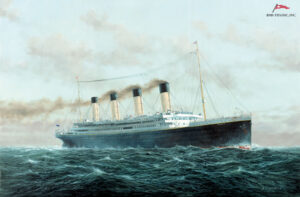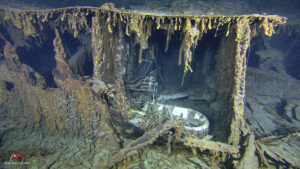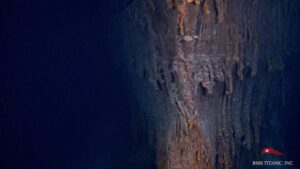Titanic Expeditions: Safeguarding the Legacy of the Titanic with RMS Titanic Inc.

The RMS Titanic is one of the most well-known ships in history. It sank on April 15, 1912, after colliding with an iceberg on her inaugural journey from Southampton to New York City. The disaster resulted in the loss of 1,496 lives out of the 2,224 passengers and crew on board. This tragedy led to significant changes in maritime safety regulations and left a lasting mark on public consciousness.
RMS Titanic, Inc. is dedicated to preserving the legacy of the Titanic. As the leading authority on Titanic expeditions, they have conducted eight research and recovery missions. These expeditions have provided invaluable insights and artifacts, ensuring that the memory of the Titanic endures. In July 2024, they will embark on their ninth expedition, marking their first return to the wreck site since 2010.
The Story of the Titanic
The Titanic was constructed by Harland and Wolff in Belfast and launched in 1912. It was the largest ship afloat at the time and boasted luxurious accommodations. These included a gymnasium, swimming pool, smoking rooms, fine restaurants, and opulent cabins. Despite its advanced safety features, such as watertight compartments and remotely activated doors, the Titanic carried only 20 lifeboats, enough for about half the people on board.
On its maiden voyage, the Titanic struck an iceberg and began to sink. Many lifeboats were launched half-empty due to panic and confusion. The disaster led to the loss of 1,496 lives, making it one of the deadliest maritime tragedies. The sinking of the Titanic had a profound impact on maritime safety regulations and remains a significant event in history.
RMS Titanic, Inc. – The Guardians of History
RMS Titanic, Inc. plays a crucial role in preserving the Titanic’s legacy. The company was granted exclusive salvage rights to the wreck by a U.S. federal court in 1994. This designation allows them to recover artifacts from the site and ensures that these efforts are conducted with respect and responsibility. Their mission combines scientific research, education, and public exhibitions.
The company’s work is vital for historical preservation and education. By recovering artifacts and conducting research, RMS Titanic, Inc. helps us understand the Titanic better. Their exhibitions showcase these artifacts, allowing the public to connect with the ship’s history.
A Closer Look at the Past Expeditions
RMS Titanic, Inc. has organized eight scientific expeditions to explore and recover artifacts from the Titanic wreck site. Each mission has yielded valuable insights and important historical items.
 1987 Expedition: The initial mission utilized advanced technology, including the manned submersible Nautile. The team recovered about 1,800 objects. Key items included instruments from the stern Docking Bridge, a decorative cherub, and leather traveling bags used by the ship’s pursers.
1987 Expedition: The initial mission utilized advanced technology, including the manned submersible Nautile. The team recovered about 1,800 objects. Key items included instruments from the stern Docking Bridge, a decorative cherub, and leather traveling bags used by the ship’s pursers.- 1993 Expedition: In collaboration with IFREMER, RMS Titanic, Inc. undertook a second joint mission in April 1993. Using the French research vessel Nadir, they retrieved around 800 artifacts, such as the ship’s whistles, a double lifeboat davit, and a two-ton engine eccentric strap. Personal belongings, including a delicate jet bead and a child’s marbles, highlighted the diverse nature of the recovered objects.
- 1994 Expedition: Returning with IFREMER, the summer 1994 expedition focused on recovering various personal effects and ship parts. Items like a boot and binoculars were retrieved, along with the precise measurement of a 17-ton hull section, which was later exhibited at the National Maritime Museum in Greenwich.
- 1996 Expedition: This mission featured groundbreaking scientific studies, employing reverse engineering and forensic techniques to examine the ship’s deterioration. The team consisted of experts from five countries. They studied iron-consuming “rusticles” and recovered significant artifacts. The Discovery Channel documented this important expedition.
- 1998 Expedition: Continuing their scientific explorations, the team discovered new debris fields and recovered notable artifacts. They included the 17-ton hull section known as “The Big Piece.” This expedition also made history by providing the first live fiber-optic television broadcast from the ocean floor, enabling real-time wreck exploration.
- 2000 Expedition: Using the Russian research vessel Keldysh and submersibles MIR I and MIR II, this mission retrieved crucial artifacts like the main wheel and steering stand from the docking bridge. The most remarkable find was 65 perfume vials belonging to a first-class passenger, which still emitted the scent of Edwardian perfume.
- 2004 Expedition: This expedition marked a shift to remotely operated vehicles (ROVs). The group used Phoenix International’s ROV to retrieve distinctive items like a gold-plated sconce from the À la Carte Restaurant and a ceramic tile from the Turkish Bath.. This technology allowed for continuous operations and meticulous documentation.
- 2010 Expedition: The latest mission, conducted in summer 2010, was the most technologically advanced. The team used innovative techniques to virtually raise the Titanic and gather detailed images and data to preserve the ship’s legacy. This expedition brought together top archaeologists, oceanographers, and scientists, significantly enhancing our understanding of the Titanic’s historical and maritime importance.
These expeditions have provided critical insights into the Titanic’s history and significance. They have also ensured that the memory of the Titanic and its artifacts are preserved for future generations.
Artifact Recovery and Preservation

RMS Titanic, Inc. has the legal right to recover artifacts from the Titanic wreck. This responsibility is taken very seriously. The artifact recovery process begins as soon as an object is lifted from the ocean floor. Immediate stabilization is necessary to prevent further deterioration. Artifacts are placed in foam-lined tubs of fresh water and cleaned with soft brushes.
Once artifacts reach the conservation laboratory, they undergo processes to remove rust and salt deposits. Metal objects are placed in a desalination bath and undergo electrolysis. Paper artifacts are freeze-dried to remove water and then cleaned with specialized vacuums and hand tools. Leather items are treated with water-soluble wax.
Artifacts are displayed in specially designed cases that control temperature, humidity, and light levels. These cases protect the artifacts from deterioration and allow them to be shown in exhibitions worldwide.
Educational Impact and Public Engagement
RMS Titanic, Inc. uses recovered artifacts for educational purposes. Their exhibitions, both touring and permanent, have been viewed by millions of people. These displays allow the public to connect with the Titanic’s history in a tangible way.
The company also incorporates artifacts into STEAM (Science, Technology, Engineering, Arts, and Mathematics) educational programs. These programs provide insightful lessons and inspire students to learn more about history and science. The educational impact of RMS Titanic, Inc.’s work is significant and helps to keep the Titanic’s legacy alive for future generations.
The Upcoming Titanic Expedition 2024
RMS Titanic, Inc. is preparing for its next expedition in July 2024. This will be the first expedition to the wreck site since 2010. Imaging and high-resolution photography will be the main goal of the mission, which will use cutting-edge technology. The goal is to keep the Titanic’s history alive so that it can be studied by scientists in the future.
The 2024 Titanic expedition will utilize remotely operated vehicles (ROVs) to survey the wreck site and debris field. The photos that are taken will provide significant new information about the state of the wreck site. Additionally, they will contribute to ongoing conservation efforts and educational programs by identifying sites and artifacts that are at risk.
The 2024 expedition by RMS Titanic, Inc. has multiple goals aimed at advancing our understanding and preservation of the Titanic wreck site. The mission focuses on four key areas: imaging, discovery, inspiration, and honoring the legacy.
- Imaging:
- Digitally document the current state of the wreck site.
- Compare new images with those taken in 2010 to assess changes.
- Analyze the condition of specific areas, such as the Marconi Wireless Room, to understand ongoing deterioration.
- Discovery:
- Investigate unexplored sections of the debris field to uncover new artifacts.
- Discover marine life that has not been observed before, enhancing our understanding of deep sea biology.
- Identify areas where the ship’s structure has deteriorated further, potentially opening new pathways into the interior.
- Inspiration:
- Involve the global community in the identification and future recovery of artifacts.
- Use exhibitions, educational programs, and digital platforms to make the wreck site accessible to the public.
- Encourage young people to pursue careers in oceanography, history, and related fields by showcasing the excitement and importance of deep-sea exploration.
- Honor:
- Pay tribute to key figures like P.H. Nargeolet who have significantly contributed to Titanic research.
- Continue the careful work of recovering and preserving artifacts to maintain the historical integrity of the site.
These goals highlight the comprehensive approach of RMS Titanic, Inc. in their ongoing efforts to preserve and study the Titanic. Each objective plays a crucial role in ensuring that the legacy of the Titanic is honored and that new generations are inspired by its history and the work being done to preserve it.
Frequently Asked Questions about Titanic Expeditions
 Why does RMS Titanic, Inc. conduct expeditions? RMS Titanic, Inc. conducts expeditions to preserve the legacy of the Titanic through continuous research, imaging, and educational initiatives. Technology is improving rapidly, allowing more advanced studies and public engagement.
Why does RMS Titanic, Inc. conduct expeditions? RMS Titanic, Inc. conducts expeditions to preserve the legacy of the Titanic through continuous research, imaging, and educational initiatives. Technology is improving rapidly, allowing more advanced studies and public engagement.- What is learned from expeditions? Expeditions provide scientific, historical, and educational insights. The data collected spans multiple domains, including climate science, marine biology, engineering, geology, geophysics, cinematography, and public policy.
- How long do Titanic expeditions take? To guarantee crew safety and respect for the Titanic site, expeditions are meticulously planned, organized, and carried out. Reaching the bottom of the ocean, where the Titanic wreckage is located, takes roughly two to three hours. The expedition’s duration is contingent upon its goals, the weather, and other variables.
- Can the public get updates on what the expedition finds? RMS Titanic, Inc. plans to release regular updates on the Titanic Expedition 2024. Following their social media channels and official website is the best way to stay informed.
- How often are expeditions conducted? RMS Titanic, Inc. has conducted eight expeditions to the wreck site between 1987 and 2010. The 2024 expedition will be their ninth mission.
- Why can RMS Titanic, Inc. recover artifacts from the wreck site? In 1994, RMS Titanic Inc. was recognized as the only salvor-in-possession of the Titanic by the U.S. District Court for the Easter District of Virginia. They are the sole entity legally permitted to recover artifacts.
- Do they sell artifacts? No, RMS Titanic, Inc. does not sell recovered artifacts. They are carefully protected, preserved, and used for educational programs and exhibitions.
- Where can the public see recovered artifacts? Recovered artifacts are displayed in permanent exhibitions in Orlando, Florida, and Las Vegas, Nevada. Touring exhibitions are also available worldwide.
Stay Up to Date on the 2024 Titanic Expedition by Following RMS Titanic Inc. Today
The RMS Titanic is a powerful symbol of human ambition and loss. RMS Titanic, Inc. works hard to keep its story alive through research, recovering artifacts, and educational programs. The 2024 expedition will give us new information about the wreck and help with ongoing preservation.
Staying involved and informed is important to keep the memory of the Titanic and its passengers alive. RMS Titanic, Inc.’s work ensures this important history is remembered.
Follow RMS Titanic, Inc. on social media and visit their website to get updates on the Titanic Expedition 2024. You can support their mission by donating, becoming a member, or visiting their exhibitions. Your support helps preserve the legacy of the Titanic for future generations.
